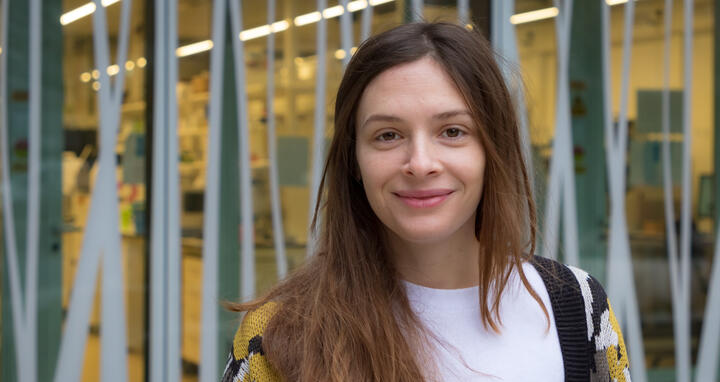Dancing spaghetti on the brain
Chaos reigns in living organisms. The aim of biophysics is to get to the bottom of this apparent disorder and understand how it is actually organized. Melissa Birol is one of the scientists working in this still relatively young field of research. As a new junior group leader, the Greek national began setting up the Single Molecule Biophysics Probing Quantitative Neuroscience Lab at the Berlin Institute for Medical Systems Biology (BIMSB) on December 1. The BIMSB is part of the Max Delbrück Center for Molecular Medicine in the Helmholtz Association (MDC).
Having completed her master’s degree and subsequent doctorate in theoretical biophysics, Melissa Birol wanted to apply this to the cellular level by getting experience in “practical and experimental work.” And this brought her to single molecule biophysics. Her fascination for disordered systems was sparked by biophysicists, Elizabeth Rhoades and Andrew Miranker, two scientists that she has worked with as a postdoctoral fellow – first at Yale and then, since 2016, at the University of Pennsylvania.
Function of disordered proteins still unexplained
We do not know what function IDPs actually serve, nor do we know what exactly happens in the cells when they lose or gain their function and eventually trigger these diseases.
At the BIMSB, she will be investigating the behavior of intrinsically disordered proteins (IDPs). These proteins are associated with neurodegenerative diseases such as Alzheimer’s, Parkinson’s and amyotrophic lateral sclerosis (ALS) – an incurable nervous system disease that leads to muscular paralysis. “IDPs are well researched,” says Birol. “For example, we already know exactly which of these proteins are associated with which diseases. Nevertheless, we do not know what function they actually serve, nor do we know what exactly happens in the cells when they lose or gain their function and eventually trigger these diseases.”
In her research, Birol will be using and developing optical microscopy and spectroscopy and applying these tools to brain organoids – mini-organs created from human stem cells that produce a replica of the brain in a petri dish. With the combination of state-of-the-art optical tools and biological systems, she wants to simulate how the proteins in brain cells behave, are invasive and how neurodegenerative diseases progress. This will involve not only observations, but also physical measurements being taken of each stage.
Diagnosis too late for therapy
Intrinsically disordered proteins have no intrinsic structure. “They are like spaghetti dancing around in the cell,” says the neuroscientist, describing the dynamics under the microscope. She observes the different states of matter that the IDPs go through: At the beginning, diffuse as only one single molecules. These then combine to create a formless, dynamic entity – which really is reminiscent of a couple of curly spaghetti – and join together with other cellular components (proteins, RNA, DNA, membranes) to form a group, eventually entering an immobile, fibrous state. This is how the protein deposits typical of Parkinson’s or Alzheimer’s disease are formed in the brain.
“By the time we see these deposits, it’s already too late and the disease can no longer be stopped,” says Birol. She therefore wants to find out what happens to these IDPs at an earlier stage – and why. “If we know why they start ‘dancing’ together in the first place and then form these stiff bundles, we could develop therapeutic approaches to halt the process.”
Birol is not restricting her research to the processes inside the neurons, but is also focusing on microglia cells. These cells are sort of the “guardians” of our gray cells: They are equipped with fine hairs which they use to constantly feel their way across the brain tissue and fend off germs, for example. They also react to protein deposits. After all, clumps of IDPs may not remain trapped in one neuron; they diffuse and may propagate from one neuron to the next, spreading throughout the brain. Birol explains that a starting point in the fight against neurodegenerative disease could therefore be to get the microglia cells to clean up the IDPs before they enter the next neuron. In addition, the scientist will also investigate how the IDPs interact with cell membranes, as perhaps a means of communication within the brain or a potential barrier that could be put in place at this stage to prevent them from spreading.
Birol says she is looking forward to the interdisciplinary collaboration at the MDC – particularly the opportunity to combine experimental with computational approaches, both in her own research lab and with other scientists.
Text: Jana Ehrhardt-Joswig






